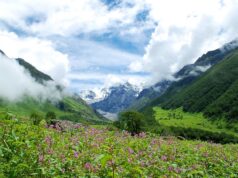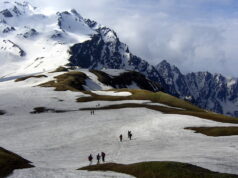India is truly a diverse country. It is called home by people that belong to different cultures and traditions. It has various regions that differ in landscape, terrain, and climatic conditions. Owing to the different terrains existing in the country there is a lot of varied wildlife, along with flora and fauna that you will find here. India is blessed to be the home of around 7 to 8 percent of total wildlife species in this world. India alone is home to more than 100 National Parks, which is a huge number for a country.
In this blog we have listed some of the best national parks of India that you must visit. If you are a nature lover, or a photography enthusiast, or a thrill seeker, these spots will be just perfect for vacation.
1 – Corbett National Park, Uttarakhand
Jim Corbett National Park was established in 1936 and was earlier known as Hailey National Park. It has the largest tiger population in the world, and is the most visited National Park of India. It is named after the British officer and Tiger Hunter Jim Corbett. It was established to preserve and protect Bengal Tigers. The national park is spread across a whopping area of 520 square kilometers. The park has five zones which are Jhirna, Dhikala, Dhela, Bijrani, and Durga Devi Zone.
However for best chances of wildlife spotting one should head to the Dhikala Zone. It is estimated that Corbett National Park is home to more than 230 tigers. It is not just the tigers but here you can spot Asiatic elephants, various species of birds, leopards, and sloth bears.
While visiting here you can choose to stay in the forest resorts in Jhirna, Dhikala, Dhela, Bijrani zone. The National park is one of the best spots for Elephant safari in India.
2 – Ranthambore National Park, Rajasthan
Ranthambore National Park is a blend of Wildlife and Heritage. It gained its recognition as being a national park and Tiger Reserve after the Project Tiger Initiative by Government of India. Initially back in ages it was a hunting ground for Kings of Jaipur. The national park is spread across a whopping area of 400 square kilometer. One of the major attraction of this national park is the Ranthambore Fort which was built in the 10th century and still serves as a tourist spot.
The national park is in a valley flanked by Aravali and Vindhya ranges. It is estimated that this National Park is home to over 50 tigers. It also houses animals such as Chinkara, Sambar Deer, and Leopards. It is also home to more than 300 species of birds, and an absolute delight for photographers.
Some of the other major highlights of the National Park are Padam Talao Lake, which is a huge lake and the Jogi Mahal which is located just by the side of the lake.
3 – Kanha National Park, Madhya Pradesh
Kanha National Park is one of the best managed National Parks of India. It was established in 1955. The National Park is estimated to be the home of more than 100 tigers. Not just the tigers, but this National Park is also popular for its population of ‘Barasingha’ or the swamp deer. The National Park breeding program of this park is believed to have saved the swamp deer from extinction in India. It is situated between the Halon and Banjar Valley, and is spread across 1900 square kilometer.
Rudyard Kipling the renowned author was so impressed by the beauty of this park’s flora, fauna and wildlife that he took inspiration from Kanha National Park for his novel ‘The Jungle Book’. This park is perfect for all the nature lovers and wildlife admirers.
The terrain of the National park consists of Sal and Bamboo forests along with open grasslands. The best chances of spotting a tiger here is in the Sal forests of the park.
4 – Bandhavgarh National Park, Madhya Pradesh
Bandhavgarh National Park was established as a National Park in 1968, while it got the status of being a tiger reserve in 1993. Earlier it was the hunting grounds of the local kings, and was a private property until later it was given to the Government of India. Bandhavgarh National Park has the highest concentration of tigers in India. It is estimated that there more than 50 tigers in this park. The national Park is spread across a whopping area of 820 square kilometers.
The national park is divided into 3 main zones, which are Bamera, Magdi and Tala. The best chances of spotting tigers however are in the Tala Zone. It is also a great spot if you have in mind to experience the elephant safari. Apart from tigers here you can also spot striped hyenas, leopards, and deer.
It is also home to more than 250 species of Birds, and must we mention that it also houses white tigers. Here you will also find thousands of year old man made caves and rock paintings.
5 – Gir National Park, Gujarat
Gir National Park was established in the year of 1965, and is the only natural habitat reserve park of Asiatic Lions in the world. At a time Asiatic Lions were close to extinction, but with the help of government initiatives now the count of Asiatic Lions in this National Park has been escalated to more than 500. The National Park is also known for its largest population of Marsh Crocodiles, anywhere in the country. The National park is also home to more than 200 leopards.
The major tourist zones of the National Park are, Gir Interpretation Zone, Gir Jungle Trail, Sasan Gir Museum, and Crocodile Breeding Center. The best chances of spotting the Asiatic lions are in the Gir Jungle Trail zone. However it is closed during the monsoon season.
It is to be taken note of that not all zones of Gir National Parks are open for public, because the authorities want to give some natural and raw space for the Lions.
6 – Kaziranga National Park, Assam
Kaziranga National Park is listed as a UNSECO World Heritage site and is the only natural habitat reserve park for one horned rhinoceros. The one horned rhinoceros of India once were on the verge of extinction, and now their number has risen up to 1800, all thanks to the initiatives of the National Park. The terrain of the national park consists of swamps, grasslands, and pools, which is perfect for rhinoceroses. Due to the terrain, Elephant safaris are the only mode of excursion over here.
Along with rhinoceroses the national park is also home to a large number of elephants. It is also home to water buffaloes, wild boars, and crocodiles. Although Kaziranga National park is also known for its tiger population but tiger spotting in the park is a rare sight.
It is to take note of that national park also has Brahmaputra River flowing through it, which gets flooded during monsoons, and makes the accessibility in the park a little difficult.
7 – Sundarbans National Park, West Bengal
Sundarbans National Park was established in the year of 1984. It has the status of UNESCO World Heritage site for being natural reserve for Tigers, and for having the largest Mangrove forest in the world. The word Sundarbans means ‘beautiful forests’ and the name Sundarbans was inspired from the Sundari trees which are commonly found in the region. The entire region of Sundarbans is spread across 40,000 square kilometers of land in India and Bangladesh.
The Indian part of the Sundarbans has more than 100 islands, and only half of them are inhabited by people. Owing to the terrain of the national park the safari mode that is possible here are only through boats which is in itself a unique experience.
Apart from a concentration of tigers, the National Park is also home to other species of wildlife such as flying fox, grey mongoose, and leopards.
8 – Bandipur National Park, Karnataka
Bandipur National Park is located in the Chamarajanagar district of Karnataka. It is one of the most popular national parks of South India and one of the tiger reserve in India. It was declared a National Park in 1974 and is spread across a whopping area of 865 Square Kilometers. This National Park is a part of Nilgiri Biosphere Reserve which is the largest protected region in Southern India. This national Park was once a hunting ground of the Kings of Mysore.
In Bandipur National Park the most commonly sighted wildlife species are that of elephants. Though it is a Tiger Reserve, but they are rarely spotted. The other wildlife species of this national park are Indian Giant Squirrels, Gray Langurs, red headed vultures, and Braking deer.
It is estimated that Bandipur National Park is home to more than 70 tigers and close to 250 Asiatic Elephants. You will also find plenty of bird’s species.
9 – Manas National Park, Assam
Manas National Park was listed as a UNESCO World Heritage site in the year of 1985, and it became a National Park in the year of 1990. Manas National Park is an elephant reserve, biosphere reserve, and a tiger reserve. The park is also known for a large population of wild water buffalo. Manas River which is a major tributary of Brahmaputra River also flows through the National Park, and it is from where the National Park has got its name.
Apart from being a wildlife reserve which offers ample amount of opportunity for wildlife spotting, this National Park is also popular amongst young crowd for river rafting, and you can also choose to explore the tea plantations that fall under the area of the National Park.
The most popular excursion mode over here is Jeep Safari. Apart from tigers, Manas National Park is also home to wildlife species such as Rhinos, golden langur, and Red Panda.
10 – Periyar National Park, Kerala
Periyar National Park was established in the year of 1982. It is located in the Western Ghats of India in Cardamom and Pandalam Hills. The National Park is spread across 777 Kilometer square of land, and it is the only Natuinal Park in India through which an artificial lake flows. Apart from the lake, there are two rivers that pass through the park and add beauty to its landscape, namely Periyar River and Pamba River. While here you must enjoy the popular boat rides of the lake.
Periyar National Park is known for being a popular Tiger Reserve, and while here you can enjoy the Jeep Safari or the Elephant Safari. The wildlife spotting might be the major highlight of this national park, but you can also choose to do camping in the forest area or go for trekking.
Apart from housing a population of tigers, it is also home to other species of wildlife such as Wild Elephants, Sambar Deer, and Leopards.
Nature never goes out of style!









































